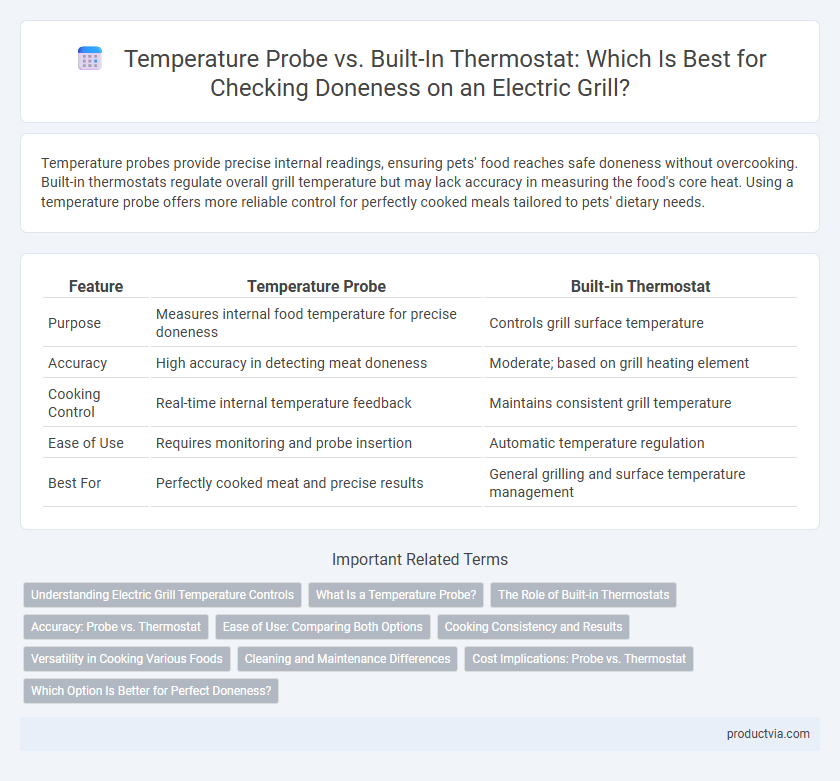Temperature probes provide precise internal readings, ensuring pets' food reaches safe doneness without overcooking. Built-in thermostats regulate overall grill temperature but may lack accuracy in measuring the food's core heat. Using a temperature probe offers more reliable control for perfectly cooked meals tailored to pets' dietary needs.
Table of Comparison
| Feature | Temperature Probe | Built-in Thermostat |
|---|---|---|
| Purpose | Measures internal food temperature for precise doneness | Controls grill surface temperature |
| Accuracy | High accuracy in detecting meat doneness | Moderate; based on grill heating element |
| Cooking Control | Real-time internal temperature feedback | Maintains consistent grill temperature |
| Ease of Use | Requires monitoring and probe insertion | Automatic temperature regulation |
| Best For | Perfectly cooked meat and precise results | General grilling and surface temperature management |
Understanding Electric Grill Temperature Controls
Electric grills use either temperature probes or built-in thermostats to regulate cooking heat and ensure precise doneness. Temperature probes provide real-time internal food temperature monitoring for accuracy, while built-in thermostats maintain consistent grill surface heat by automatically adjusting power levels. Understanding the differences between these controls helps optimize cooking performance and achieve desired results on electric grill models.
What Is a Temperature Probe?
A temperature probe is a digital sensor inserted directly into the food to measure its internal temperature, providing precise and real-time data to ensure perfect doneness. Unlike built-in thermostats that regulate the grill's surface heat, temperature probes monitor the actual core temperature of meats or other dishes, minimizing the risk of undercooking or overcooking. This technology enhances cooking accuracy, especially for recipes requiring specific internal temperatures for safety and flavor optimization.
The Role of Built-in Thermostats
Built-in thermostats in electric grills provide precise temperature control, ensuring consistent cooking results by automatically maintaining set heat levels. Unlike external temperature probes, these thermostats monitor internal grill temperature directly, reducing the risk of overcooking or undercooking food. Their integration simplifies the cooking process, enhancing convenience and accuracy for achieving perfect doneness.
Accuracy: Probe vs. Thermostat
Temperature probes provide superior accuracy by directly measuring the internal temperature of the food, ensuring precise doneness without guessing. Built-in thermostats regulate the grill's surface temperature but cannot accurately detect the food's internal heat, leading to potential undercooking or overcooking. Using a temperature probe eliminates uncertainty and improves cooking results by delivering real-time, precise internal temperature data.
Ease of Use: Comparing Both Options
Temperature probes offer precise monitoring by allowing users to check internal food temperature without interrupting cooking, enhancing ease of use for achieving perfect doneness. Built-in thermostats simplify operation by automatically regulating heat levels, eliminating the need for manual adjustments and enabling consistent cooking with minimal effort. Both options improve user convenience, but temperature probes provide greater control for those seeking accuracy, while thermostats prioritize straightforward, hands-off grilling.
Cooking Consistency and Results
A temperature probe provides precise internal heat readings, ensuring consistent doneness by monitoring the exact core temperature of food during cooking. Built-in thermostats regulate surface temperature but may lead to variable results due to uneven heat distribution, affecting cooking consistency. Using a temperature probe enhances accuracy and predictability in achieving perfect cooking results on an electric grill.
Versatility in Cooking Various Foods
Temperature probes provide precise internal readings, allowing for accurate measurement of doneness across a wide range of foods, enhancing versatility in cooking meats, poultry, and fish. Built-in thermostats regulate the grill's surface temperature, ensuring consistent heat distribution ideal for cooking vegetables and delicate items that require stable temperatures. Combining both features maximizes cooking flexibility by catering to different food types and preparation methods.
Cleaning and Maintenance Differences
Temperature probes in electric grills require careful cleaning after each use to prevent food residue buildup and ensure accurate readings, often needing manual wiping or specialized cleaning tools. Built-in thermostats are integrated within the grill, reducing direct food contact and simplifying maintenance, although they may require occasional calibration to maintain temperature accuracy. Overall, temperature probes demand more hands-on cleaning, while built-in thermostats offer a more low-maintenance solution for monitoring doneness.
Cost Implications: Probe vs. Thermostat
Temperature probes generally incur higher costs due to their advanced sensor technology and need for external calibration, enhancing precise doneness measurement in electric grills. Built-in thermostats offer a more cost-effective solution by regulating heat internally but may sacrifice accuracy, potentially leading to uneven cooking. Choosing between the two involves balancing upfront investment against long-term cooking consistency and energy efficiency.
Which Option Is Better for Perfect Doneness?
Temperature probes provide precise internal meat temperature readings, ensuring perfect doneness by directly measuring the food's core heat. Built-in thermostats regulate the grill's surface temperature but may lack accuracy in assessing internal meat temperatures, potentially leading to uneven cooking. For consistent and accurate doneness, temperature probes are generally the superior choice over built-in thermostats.
Temperature probe vs built-in thermostat for doneness Infographic

 productvia.com
productvia.com